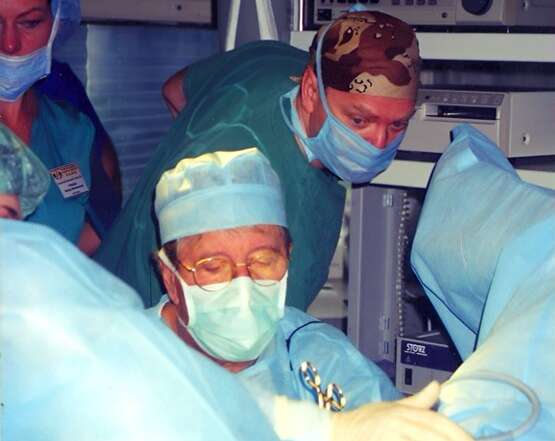Authors / metadata
DOI: 10.36205/trocar4.2023000
Article
The literature in Gynaecology for the last 30-40 years highlights the low percentages of hysterectomies performed vaginally, where there are no obvious contraindications. When compared to the other routes of hysterectomy, in terms of performance, duration, cost and complication rates, the vaginal route offers more rapid recoveries, more rapid return to daily activities, and is more cost effective.
The laparoscopic route of hysterectomy appears, recently, to be replacing vaginal hysterectomy as the preferred route, a transformation driven by trade and the ever-expanding fascination with technology. This change in preference has resulted in generations of surgeons that lack the skill set necessary to perform basic vaginal hysterectomy. These surgeons will therefore refrain from performing a routine vaginal hysterectomy, when it should be the preferred route.
Historically the first hysterectomy performed was a vaginal hysterectomy (VH). VH dates back to ancient times, and was probably performed by Themison of Athens in 50BC (1) and definitively performed by Soranus of Ephesus in 120 years AD (1). VH was also mentioned in Alshahavarious’ writings of 11th century: “if uterus has prolapsed externally and could not be reinserted, it should be surgically excised” (2). These hysterectomies were carried out sporadically and only for the reason of uterine prolapse or uterine inversion. However, the bladder and the ureter were often torn and the patient rarely survived.
Vaginal hysterectomy found in the descriptions of Berengario de Capri of Bologna in the Middle Ages (1470-1550) (3) and the first planned VH was performed by Conrad Lagenbeck of Gottingen in 1813. His patient made an uneventful recovery and lived for 26 years after the vaginal hysterectomy (4). The first recorded subtotal hysterectomy was performed by Charles Clay in 1843, in Manchester, England (1).
One of the strongest proponents of vaginal hysterectomy was Noble Sproat Heaney of Chicago who in 1934 reported a series of 627 VH for benign pelvic disease resulting in death in only three cases (3). During this period, the first part of the 20th century the VH had fallen out of favour as the general surgeons, not being familiar with the vaginal surgery, favoured the abdominal route. The first total abdominal hysterectomy (TAH) was performed by Richardson in 1929 in the United States of America (USA) (1). Despite Richardson’s recommendations, subtotal hysterectomy remained the preferred surgical technique until the late 1940’s, supracervical hysterectomies were preferred due to theoretical reduced risk of bladder and ureter injury, as well as avoiding opening the vagina, the risk of contamination with vaginal flora was eliminated. The advent of antibiotics, blood transfusion, modern anesthesia and the recognition that cancer occasionally developed in the cervical stump, encouraged the surgeons to carry out TAH. For the next 50 years or so no further conceptual advances in the technique were introduced until the advent of endoscopic surgery. During this period the technique of TAH has improved. The introduction of Pfannenstiel incision with cosmetic results and safety led to the explosive increase of the number of TAH seen today.
The introduction of Laparoscopic assisted vaginal hysterectomy (LAVH) in 1984 by Kurt Semm (5,6), and the Total Laparoscopic Hysterectomy (TLH) in 1989 by Reich in 1989 (7,8), revolutionized the surgical approach to hysterectomies. Both the above authors intention was to decrease the number of hysterectomies performed abdominally and not to replace the VH as seen today. We shouldn’t forget that these conceptual advancements necessitating new skills and equipment represent a new technique for an old procedure- the VH.
With the introduction of Laparoscopic Hysterectomy (LH) in the last part of the 20thcentury, the concept of minimally invasive hysterectomy (MIH) emerged. The question is why VH, a long-practice procedure dating back to Themison in 50BC, meeting all the parameters of MIH namely, avoidance of large painful abdominal scars, less need for analgesia, rapid recovery and return to daily activities among other benefits, does not hold preferential place amongst surgeons with the AH and LH routes being the first choice?
Hysterectomy remains one of the most common operative procedures for benign uterine diseases performed today in developed countries (9,10), yet the route of hysterectomy for benign uterine conditions continues to excite controversy and debate. It can be performed abdominally, vaginally, or laparoscopically, with or without robotic assistance. The surgical approach of hysterectomy is the most important factor responsible for postoperative morbidity. Many studies have compared the surgical approach and complications according to the type of surgery to determine which method is best for the patient. The conclusion suggests that abdominal hysterectomy is inferior to VH and LH. The advantages provided by LH/RH and VH over open abdominal hysterectomy (AH) include less postoperative pain, less need of analgesia, shorter hospital stay, and more rapid recovery and return to daily activities (11-15). Additionally, there are fewer intra-operative and postoperative complications reported with vaginal hysterectomy as compared with abdominal hysterectomy (AH) or laparoscopic hysterectomy (LH) (16-18). However, AH for benign uterine conditions remains the chosen route worldwide. This preference, is largely due to a lack of experience in VH, resulting in surgeons’ reluctance to perform VH, especially in patients without uterine prolapse, with uterine fibroids, previous caesarean sections, previous laparotomies, as well as in nulliparous women. Correctly challenging these contraindications may lay the foundation for implementing different approaches towards an increased number of VHs (19-24).
In spite of the benefits offered by VH, globally, 70-80% of hysterectomies have been shown tobe carried out via the abdominal approach,according to all large-scale surveys (25-37),except when treating uterovaginal prolapse, forwhich the vaginal route is generally preferred.This latter indication accounts for about 10% ofall hysterectomies conducted worldwide (38).The rate of LH has been shown to be increasing,without a significant reduction in AHs. Thisincrease in LH has thus been incurred at theexpense of VH while, ideally, it is the VH rate thatshould increase at the expense of the AH rate.
It is a common perception that the decreasing VH rate, which came about as a consequence of the dependence on LH, may be at least partially attributed to the impact of the industry that manufactures and promotes the laparoscopic equipment. The introduction of robotics has changed the rates in favor of robotic hysterectomy (RH). In the hospitals where the RH was introduced in United States of America (USA), the number of RHs increased with a further decline not only in VH but also in conventional LH (39). It seems like hysterectomies which can be performed vaginally or laparoscopically are now done robotically.
Assessing current trends in resident hysterectomy training it is obvious that VH is not promoted as should be when deciding the route of hysterectomy. When deciding the route of hysterectomy, the preference and proficiency of the surgeon may be the most decisive factors. As a result, if LH is performed more often than VH, gynecologists in the future will be unfamiliar with VH, leading to a more profound decrease in the implementation of VH. This was demonstrated in a survey amongst residents performed in the USA in 2011, by Antosh et al (40). In this survey, only 41.7% of residents reported VH as their preferred route of hysterectomy, as compared to 47.1% who preferred laparoscopic approaches (40). Similar findings were reported by Burkett et al. who concluded that there is an increase in endoscopic approach, including robotic hysterectomy (RH), while VH is becoming inappropriately replaced and underutilized (41).
This highlights a fundamental problem currently facing clinical gynecology, namely insufficient VH training/practice due to the inadequate experience of junior trainers in VH, and the consequent lack of appreciation of the benefits afforded by VH. It is evident from the literature that the vaginal route should be considered the preferred choice. VH skill should not be sacrificed in favor of LH or RH. Academic institutions worldwide are urged to review a strategy in order to retain the skill of VH, via appropriate training programs. Surgeon training and experience have often been deemed particularly influential leading factors for the selection of the most appropriate approach to hysterectomy. Failure to achieve proficiency during training as a registrar due to the lack of training and experience in VH has been raised by several authors as being an important obstacle in performing VH. Lack of experience in vaginal surgery leading to gynecologists having a dependence on the abdominal and/or laparoscopic routes when contemplating hysterectomy (42-45).
Aside from personal training, other factors that are considered prerequisites for a successful VH are vaginal accessibility, together with the size and mobility of the uterus (46). The ACOG has stated that VH is indicated for patients with a mobile uterus of less than 12 weeks gestational size (47). The International Society for Gynecologic Endoscopy promoting vaginal surgery (ISGE), introduced evidence-based guidelines for selection of women who can had undergone uncomplicated VH as well as practical guidelines for safe performance of VH (48,49). Incorporation of these guidelines into the residents training programme, can increase the rate of VH and result in an overall decline in open AH and LH (50).
We demonstrated in an academic institution in South Africa, that when formal institutional guidelines and surgical decision algorithm are introduced into the residents training program this promotes the vaginal approach to hysterectomy in patients with benign disease and non-prolapsed uterus (49). In our Institution, the proportion of hysterectomies performed abdominally decreased from 91.2% to 51.6% and those performed vaginally increased from 9.8% to 48.4% from the beginning of the study in July 2001 to its end in December 2014. The VH to AH ratio, therefore, was increased from 1:9 to 1:1. Based on this, it seems that as much as 40 % of feasible vaginal procedures were replaced by a more invasive approach, AH/ LH, when guidelines and surgical decision algorithm were not used (50). This study is in agreement with other large studies, which indicate that, the implementation of a clinical pathway and hysterectomy guidelines can be associated with a decrease in the proportion of hysterectomies performed abdominally (42,46,51). By increasing the rate of VH in our institution, we achieved greater exposure and training at resident level, providing the possibility of true proficiency that could be passed to others. Future studies will indicate the effects of these clinical and education strategies in increasing the rates of VH worldwide.
Conclusion
Literature review reveals that when hysterectomy for benign uterine disease is undertaken, VH should be considered as the ideal surgical approach amongst minimally invasive hysterectomies. Despite evidence supporting the benefits of VH, current statistics indicates that VH is underutilised. The decreased utilisation of VH is undesirable because VH is the least invasive approach with shorter operating time and is less costly. The introduction of the guidelines proposed at our institution into the registrar training program can lead to a decrease of hysterectomies performed abdominally and an increase in hysterectomies performed vaginally which may be achieved without inappropriate increase in laparoscopic or robotic hysterectomy. Minimally invasive gynaecologic surgeons around the world should focus on the VH training, skills and proficiency among residents. It is true that all of hysterectomy cannot be performed by VH, but for patients with similar indications and uterine weight, all of hysterectomy should not be performed by laparoscopic or robotic hysterectomy. Based on the benefits offered by VH, I consider that nobody can call himself or herself a minimally invasive gynaecologic surgeon if not able to perform a VH in selected patients with benign uterine diseases and non-prolapsed uterus. The evidence overwhelming in favour of VH hence, all efforts should be directed to revive VH. VH should not be sacrificed on the altar of any further debate or dispute.


